Diversity of the Biological and Proteinogenic Characteristics of Quinoa Genotypes as a Multi-Purpose Crop
Abstract
1. Introduction
2. Materials and Methods
2.1. Experimental Site and Design
2.2. Plant Materials and plot Preparation
2.3. Growth and Productivity Characteristics
2.4. Determination of Amino Acids and Protein Contents in Quinoa Grains
3. Results
Quinoa Growth Characteristics
4. Discussion
5. Conclusions
Author Contributions
Funding
Data Availability Statement
Conflicts of Interest
References
- Risi, J.C. The Chenopodium grains of the Andes: Inca crops for modern agriculture. Adv. Appl. Biol. 1984, 10, 145–216. [Google Scholar]
- Bhargava, A.; Shukla, S.; Srivastava, J.; Singh, N.; Ohri, D. Genetic diversity for mineral accumulation in the foliage of Chenopodium spp. Sci. Hortic. 2008, 118, 338–346. [Google Scholar] [CrossRef]
- Pereira, E.; Encina-Zelada, C.; Barros, L.; Gonzales-Barron, U.; Cadavez, V.; Ferreira, I.C. Chemical and nutritional characterization of Chenopodium quinoa Willd (quinoa) grains: A good alternative to nutritious food. Food Chem. 2019, 280, 110–114. [Google Scholar] [CrossRef] [PubMed]
- De Ron, A.M.; Sparvoli, F.; Pueyo, J.J.; Bazile, D. The Challenge of Protein Crops as a Sustainable Source of Food and Feed for the Future; Frontiers Media SA: Lausanne, Switzerland, 2017. [Google Scholar]
- Hlásná Čepková, P.; Dostalíková, L.; Viehmannová, I.; Jágr, M.; Janovská, D. Diversity of quinoa genetic resources for sustainable production: A survey on nutritive characteristics as influenced by environmental conditions. Front. Sustain. Food Syst. 2022, 501. [Google Scholar] [CrossRef]
- Cancino-Espinoza, E.; Vázquez-Rowe, I.; Quispe, I. Organic quinoa (Chenopodium quinoa L.) production in Peru: Environmental hotspots and food security considerations using Life Cycle Assessment. Sci. Total Environ. 2018, 637, 221–232. [Google Scholar] [CrossRef] [PubMed]
- Hinojosa, L.; González, J.; Barrios-Masias, F.; Fuentes, F.; Murphy, K. Quinoa abiotic stress responses: A review. Plants 2018, 7, 106. [Google Scholar] [CrossRef]
- Adolf, V.I.; Jacobsen, S.-E.; Shabala, S. Salt tolerance mechanisms in quinoa (Chenopodium quinoa Willd.). Environ. Exp. Bot. 2013, 92, 43–54. [Google Scholar] [CrossRef]
- Aloisi, I.; Parrotta, L.; Ruiz, K.B.; Landi, C.; Bini, L.; Cai, G.; Biondi, S.; Del Duca, S. New insight into quinoa seed quality under salinity: Changes in proteomic and amino acid profiles, phenolic content, and antioxidant activity of protein extracts. Front. Plant Sci. 2016, 7, 656. [Google Scholar] [CrossRef]
- Noulas, C.; Tziouvalekas, M.; Vlachostergios, D.; Baxevanos, D.; Karyotis, T.; Iliadis, C. Adaptation, agronomic potential, and current perspectives of quinoa under mediterranean conditions: Case studies from the lowlands of central Greece. Commun. Soil Sci. Plant Anal. 2017, 48, 2612–2629. [Google Scholar]
- Bazile, D.; Jacobsen, S.-E.; Verniau, A. The global expansion of quinoa: Trends and limits. Front. Plant Sci. 2016, 7, 622. [Google Scholar] [CrossRef]
- Dost, M. Field evaluation results across locations and identification of suitable QUINOA varieties. In Wrap up Workshop of Regional Quinoa Project (TCP/RAB/3403–FAO); Food and Agriculture Organization of the United Nations: Rome, Italy, 2015. [Google Scholar]
- Taaime, N.; El Mejahed, K.; Moussafir, M.; Bouabid, R.; Oukarroum, A.; Choukr-Allah, R.; El Gharous, M. Early Sowing of Quinoa Cultivars, Benefits from Rainy Season and Enhances Quinoa Development, Growth, and Yield under Arid Condition in Morocco. Sustainability 2022, 14, 4010. [Google Scholar] [CrossRef]
- De Santis, G.; D’Ambrosio, T.; Rinaldi, M.; Rascio, A. Heritabilities of morphological and quality traits and interrelationships with yield in quinoa (Chenopodium quinoa Willd.) genotypes in the Mediterranean environment. J. Cereal Sci. 2016, 70, 177–185. [Google Scholar] [CrossRef]
- Jacobsen, S.-E. The scope for adaptation of quinoa in Northern Latitudes of Europe. J. Agron. Crop Sci. 2017, 203, 603–613. [Google Scholar] [CrossRef]
- Lim, J.G.; Park, H.-M.; Yoon, K.S. Analysis of saponin composition and comparison of the antioxidant activity of various parts of the quinoa plant (Chenopodium quinoa Willd.). Food Sci. Nutr. 2020, 8, 694–702. [Google Scholar] [CrossRef] [PubMed]
- Ebrahimikia, M.; Jami Moeini, M.; Marvi, H.; Hasheminejhad, Y.; Ghasemzadeh Ganjehie, M. Agro-physiological response of quinoa (Chenopodium quinoa Willd.) to the nitrogen application rate and split application method. J. Soil Sci. Plant Nutr. 2021, 21, 3437–3450. [Google Scholar] [CrossRef]
- Goldberger, J.R.; Detjens, A.C. Organic farmers’ interest in quinoa production in the western United States. Food Stud. Interdiscip. J. 2019, 9, 17–35. [Google Scholar] [CrossRef]
- Kaur, R.; Ahluwalia, P.; Sachdev, P.A.; Kaur, A. Development of gluten-free cereal bar for gluten intolerant population by using quinoa as major ingredient. J. Food Sci. Technol. 2018, 55, 3584–3591. [Google Scholar] [CrossRef] [PubMed]
- Asher, A.; Galili, S.; Whitney, T.; Rubinovich, L. The potential of quinoa (Chenopodium quinoa) cultivation in Israel as a dual-purpose crop for grain production and livestock feed. Sci. Hortic. 2020, 272, 109534. [Google Scholar] [CrossRef]
- Peiretti, P.G.; Gai, F.; Tassone, S. Fatty acid profile and nutritive value of quinoa (Chenopodium quinoa Willd.) seeds and plants at different growth stages. Anim. Feed Sci. Technol. 2013, 183, 56–61. [Google Scholar] [CrossRef]
- Dwivedi, S.; Sahrawat, K.; Upadhyaya, H.; Ortiz, R. Food, nutrition and agrobiodiversity under global climate change. Adv. Agron. 2013, 120, 1–128. [Google Scholar]
- Darwinkel, A.; Stølen, O. Understanding the Quinoa Crop: Guidelines for Growing in Temperate Regions of NW Europe; EC: 1997. Available online: https://books.google.co.jp/books/about/Understanding_the_Quinoa_Crop.html?id=jpA7HAAACAAJ&redir_esc=y (accessed on 27 November 2022).
- Ramos, N.; Cruz, A.M. Evaluation of seven seasonal crops for forage production during the dry season in Cuba. Cuban J. Agric. Sci. 2002, 36, 271–276. [Google Scholar]
- Schekoldina, T.V.; Rodionova, L.Y.; Chernikhovets, E.A. Innovative culture of quinoa (Chenopodium quinoa)-prospects for growing in the Krasnodar Territory to create food of high nutritional value. Sci. J. KubGAU 2016, 121, 1–15. [Google Scholar]
- Abdelkader, M.M.; Elsayed, H.M.A. Biodiversity of Photosynthetic Pigments, Macronutrients Uptake and Fruit Quality of Tomato Genotypes. Russ. J. Plant Physiol. 2022, 69, 1–13. [Google Scholar] [CrossRef]
- Abdelkader, M.; Geioushy, R.A.; Fouad, O.A.; Khaled, A.G.A.; Liudmila, P.V. Investigation the activities of photosynthetic pigments, antioxidant enzymes and inducing genotoxicity of cucumber seedling exposed to copper oxides nanoparticles stress. Sci. Hortic. 2022, 305, 111364. [Google Scholar] [CrossRef]
- ISTA International Rules for Seed Testing. Edition 2006; International Seed Testing Association Bassersdorf: Wallisellen, Switzerland, 2006.
- Hernández-Herrera, R.M.; Santacruz-Ruvalcaba, F.; Ruiz-López, M.A.; Norrie, J.; Hernández-Carmona, G. Effect of liquid seaweed extracts on growth of tomato seedlings (Solanum lycopersicum L.). J. Appl. Phycol. 2014, 26, 619–628. [Google Scholar] [CrossRef]
- Kader, M.A. A comparison of seed germination calculation formulae and the associated interpretation of resulting data. J. Proceeding R. Soc. New South Wales 2005, 138, 65–75. [Google Scholar]
- Tangolar, S.; Turan, M.; Tangolar, S.; Ateş, F. Evaluation of amino acid contents and enzyme activities of seeds from Semillon and Carignane wine grape cultivars grown under different irrigation conditions. Sci. Hortic. 2019, 251, 181–188. [Google Scholar] [CrossRef]
- Aryal, J.P.; Manchanda, N.; Sonobe, T. Expectations for household food security in the coming decades: A global scenario. In Future Foods; Elsevier: Amsterdam, The Netherlands, 2022; pp. 107–131. [Google Scholar]
- Choukr-Allah, R.; Rao, N.K.; Hirich, A.; Shahid, M.; Alshankiti, A.; Toderich, K.; Gill, S.; Butt, K.U.R. Quinoa for Marginal Environments: Toward Future Food and Nutritional Security in MENA and Central Asia Regions. Front. Plant Sci. 2016, 7, 346. [Google Scholar] [CrossRef] [PubMed]
- Bvenura, C.; Kambizi, L. Future grain crops. In Future Foods; Elsevier: Amsterdam, The Netherlands, 2022; pp. 81–105. [Google Scholar]
- Singh, M.P.; Soni, K.; Bhamra, R.; Mittal, R.K. Superfood: Value and Need. Curr. Nutr. Food Sci. 2022, 18, 65–68. [Google Scholar] [CrossRef]
- Rojas, W.; Pinto, M.; Alanoca, C.; Gomez Pando, L.; Leon-Lobos, P.; Alercia, A.; Diulgheroff, S.; Padulosi, S.; Bazile, D. Quinoa genetic resources and ex situ conservation. In State of the Art Report on Quinoa around the World in 2013; FAO: Rome, Italy, 2015. [Google Scholar]
- Council, N.R. Lost Crops of the Incas: Little-Known Plants of the Andes with Promise for Worldwide Cultivation; National Academies Press: Washington, DC, USA, 1989. [Google Scholar]
- Christensen, S.A.; Pratt, D.B.; Pratt, C.; Nelson, P.T.; Stevens, M.R.; Jellen, E.N.; Coleman, C.E.; Fairbanks, D.J.; Bonifacio, A.; Maughan, P.J. Assessment of genetic diversity in the USDA and CIP-FAO international nursery collections of quinoa (Chenopodium quinoa Willd.) using microsatellite markers. Plant Genet. Resour. 2007, 5, 82–95. [Google Scholar] [CrossRef]
- Hussain, M.I.; Farooq, M.; Syed, Q.A.; Ishaq, A.; Al-Ghamdi, A.A.; Hatamleh, A.A. Botany, nutritional value, phytochemical composition and biological activities of quinoa. Plants 2021, 10, 2258. [Google Scholar] [CrossRef] [PubMed]
- Jacobsen, S.-E. The worldwide potential for quinoa (Chenopodium quinoa Willd.). Food Rev. Int. 2003, 19, 167–177. [Google Scholar] [CrossRef]
- Katwal, T.B.; Bazile, D. First adaptation of quinoa in the Bhutanese mountain agriculture systems. PloS ONE 2020, 15, e0219804. [Google Scholar] [CrossRef] [PubMed]
- Jacobsen, S.-E. Adaptation of quinoa (Chenopodium quinoa) to Northern European agriculture: Studies on developmental pattern. Euphytica 1997, 96, 41–48. [Google Scholar] [CrossRef]
- Jacobsen, S.-E.; Stølen, O. Quinoa-morphology, phenology and prospects for its production as a new crop in Europe. Eur. J. Agron. 1993, 2, 19–29. [Google Scholar] [CrossRef]
- Spehar, C.R.; Santos, R.L. de B. Agronomic performance of quinoa selected in the Brazilian Savannah. Pesqui. Agropecuária Bras. 2005, 40, 609–612. [Google Scholar] [CrossRef]
- Mustafa, T.A.N.; Temel, S. Performance of some quinoa (Chenopodium quinoa Willd.) genotypes grown in different climate conditions. Turk. J. Field Crops 2018, 23, 180–186. [Google Scholar]
- AlKhamisi, S.A.; Nadaf, S.K.; Al-Jabri, N.M.; Al-Hashmi, K.S.; Al-Shirawi, A.I.; Khan, R.R.; Al-Sulaimi, H.A.; Al-Azri, M.S. Productivity of Quinoa (Chenopodium quinoa L.) Genotypes Across Different Agro-Ecological Regions of Oman. Open Agric. J. 2021, 15, 98–109. [Google Scholar] [CrossRef]
- Bazile, D.; Bertero, H.D.; Nieto, C. State of the Art Report on Quinoa around the World in 2013; FAO & CIRAD: Rome, Italy, 2015. [Google Scholar]
- Casler, M.D. Breeding forage crops for increased nutritional value. In Advances in Agronomy; Elsevier: Amsterdam, The Netherlands, 2001. [Google Scholar]
- Singh, B.R.; Singh, D.P. Agronomic and physiological responses of sorghum, maize and pearl millet to irrigation. Field Crops Res. 1995, 42, 57–67. [Google Scholar] [CrossRef]
- Manjarres-Hernández, E.H.; Arias-Moreno, D.M.; Morillo-Coronado, A.C.; Ojeda-Pérez, Z.Z.; Cárdenas-Chaparro, A. Phenotypic characterization of quinoa (Chenopodium quinoa Willd.) for the selection of promising materials for breeding programs. Plants 2021, 10, 1339. [Google Scholar] [CrossRef] [PubMed]
- Samadzadeh, A.; Zamani, G.; Fallahi, H.-R. Possibility of quinoa production under South-Khorasan climatic condition as affected by planting densities and sowing dates. Appl. Field Crops Res. 2020, 33, 82–104. [Google Scholar]
- Harper, J.L. Population Biology of Plants; Academic Press: London, UK, 1990. [Google Scholar]
- Ellison, A.M. Interspecific and intraspecific variation in seed size and germination requirements of Sarracenia (Sarraceniaceae). Am. J. Bot. 2001, 88, 429–437. [Google Scholar] [CrossRef]
- Baskin, C.C.; Baskin, J.M. Seeds: Ecology, Biogeography, and, Evolution of Dormancy and Germination; Elsevier: Amsterdam, The Netherlands, 1998. [Google Scholar]
- Leubner-Metzger, G.; Knight, C.; Linkies, A.; Graeber, K.; Knight, C. The evolution of seeds. New Phytol. 2010, 186, 817–831. [Google Scholar]
- Tremayne, M.A.; Richards, A.J. Seed weight and seed number affect subsequent fitness in outcrossing and selfing Primula species. New Phytol. 2000, 148, 127–142. [Google Scholar] [CrossRef]
- Repo-Carrasco, R.; Espinoza, C.; Jacobsen, S.-E. Nutritional value and use of the Andean crops quinoa (Chenopodium quinoa) and kañiwa (Chenopodium pallidicaule). Food Rev. Int. 2003, 19, 179–189. [Google Scholar] [CrossRef]
- Bhargava, A.; Shukla, S.; Ohri, D. Chenopodium quinoa—An Indian perspective. Ind. Crops Prod. 2006, 23, 73–87. [Google Scholar] [CrossRef]
- Sánchez, J.; Albornoz, F.; Contreras, S. High Nitrogen Fertilization Decreases Seed Weight but Increases Longevity in Tomato Seeds. Horticulturae 2022, 8, 942. [Google Scholar] [CrossRef]
- Präger, A.; Munz, S.; Nkebiwe, P.; Mast, B.; Graeff-Hönninger, S. Yield and Quality Characteristics of Different Quinoa (Chenopodium quinoa Willd.) Cultivars Grown under Field Conditions in Southwestern Germany. Agronomy 2018, 8, 197. [Google Scholar] [CrossRef]
- Wali, A.M.; Kenawey, M.K.; Ibrahim, O.M.; El Lateef, E.M.A. Productivity of Quinoa (Chenopodium quinoa L.) under new reclaimed soil conditions at north-western coast of Egypt. Bull. Natl. Res. Cent. 2022, 46, 38. [Google Scholar] [CrossRef]
- Eisa, S.S.; Abd El Samad, E.H.; Hussin, S.A.; Ali, E.A.; Ebrahim, M.; González, J.A.; Ordano, M.A.; Erazzú, L.E.; El Bordeny, N.E.; Abdel-Ati, A.A. Quinoa in Egypt-plant density effects on seed yield and nutritional quality in marginal regions. Middle East J. Appl. Sci. 2018, 8, 515–522. [Google Scholar]
- Abdelkader, M.; Voronina, L.; Puchkov, M.; Shcherbakova, N.; Pakina, E.; Zargar, M.; Lyashko, M. Seed Priming with Exogenous Amino Acids Improves Germination Rates and Enhances Photosynthetic Pigments of Onion Seedlings (Allium cepa L.). Horticulturae 2023, 9, 80. [Google Scholar] [CrossRef]
- Demir, I.; Ozden, E.; Yıldırım, K.C.; Sahin, O.; Van Staden, J. Priming with smoke-derived karrikinolide enhances germination and transplant quality of immature and mature pepper seed lots. S. Afr. J. Bot. 2018, 115, 264–268. [Google Scholar] [CrossRef]
- Strenske, A.; de Vasconcelos, E.S.; Egewarth, V.A.; Herzog, N.F.M.; Malavasi, M. de M. Responses of quinoa (Chenopodium quinoa Willd.) seeds stored under different germination temperatures. Acta Sci. Agron. 2017, 39, 83–88. [Google Scholar] [CrossRef]
- Wang, N.; Wang, F.; Shock, C.C.; Meng, C.; Qiao, L. Effects of management practices on quinoa growth, seed yield, and quality. Agronomy 2020, 10, 445. [Google Scholar] [CrossRef]
- Vega-Gálvez, A.; Miranda, M.; Vergara, J.; Uribe, E.; Puente, L.; Martínez, E.A. Nutrition facts and functional potential of quinoa (Chenopodium quinoa willd.), an ancient Andean grain: A review. J. Sci. Food Agric. 2010, 90, 2541–2547. [Google Scholar] [CrossRef]
- Filho, A.M.M.; Pirozi, M.R.; Borges, J.T.D.S.; Pinheiro Sant’Ana, H.M.; Chaves, J.B.P.; Coimbra, J.S.D.R. Quinoa: Nutritional, functional, and antinutritional aspects. Crit. Rev. Food Sci. Nutr. 2017, 57, 1618–1630. [Google Scholar] [CrossRef]
- Mariotti, F.; Gardner, C.D. Dietary protein and amino acids in vegetarian diets—A review. Nutrients 2019, 11, 2661. [Google Scholar] [CrossRef]
- Craig, W.J.; Mangels, A.R. Position of the American Dietetic Association: Vegetarian diets. J. Am. Diet. Assoc. 2009, 109, 1266–1282. [Google Scholar]
- Angeli, V.; Miguel Silva, P.; Crispim Massuela, D.; Khan, M.W.; Hamar, A.; Khajehei, F.; Graeff-Hönninger, S.; Piatti, C. Quinoa (Chenopodium quinoa Willd.): An overview of the potentials of the “Golden Grain” and socio-economic and environmental aspects of its cultivation and marketization. Foods 2020, 9, 216. [Google Scholar] [CrossRef]
- Vidueiros, S.M.; Curti, R.N.; Dyner, L.M.; Binaghi, M.J.; Peterson, G.; Bertero, H.D.; Pallaro, A.N. Diversity and interrelationships in nutritional traits in cultivated quinoa (Chenopodium quinoa Willd.) from Northwest Argentina. J. Cereal Sci. 2015, 62, 87–93. [Google Scholar] [CrossRef]
- Abdelkader, M.; Zargar, M.; Murtazova, K.M.-S.; Nakhaev, M.R. Life Cycle Assessment of the Cultivation Processes for the Main Vegetable Crops in Southern Egypt. Agronomy 2022, 12, 1527. [Google Scholar] [CrossRef]
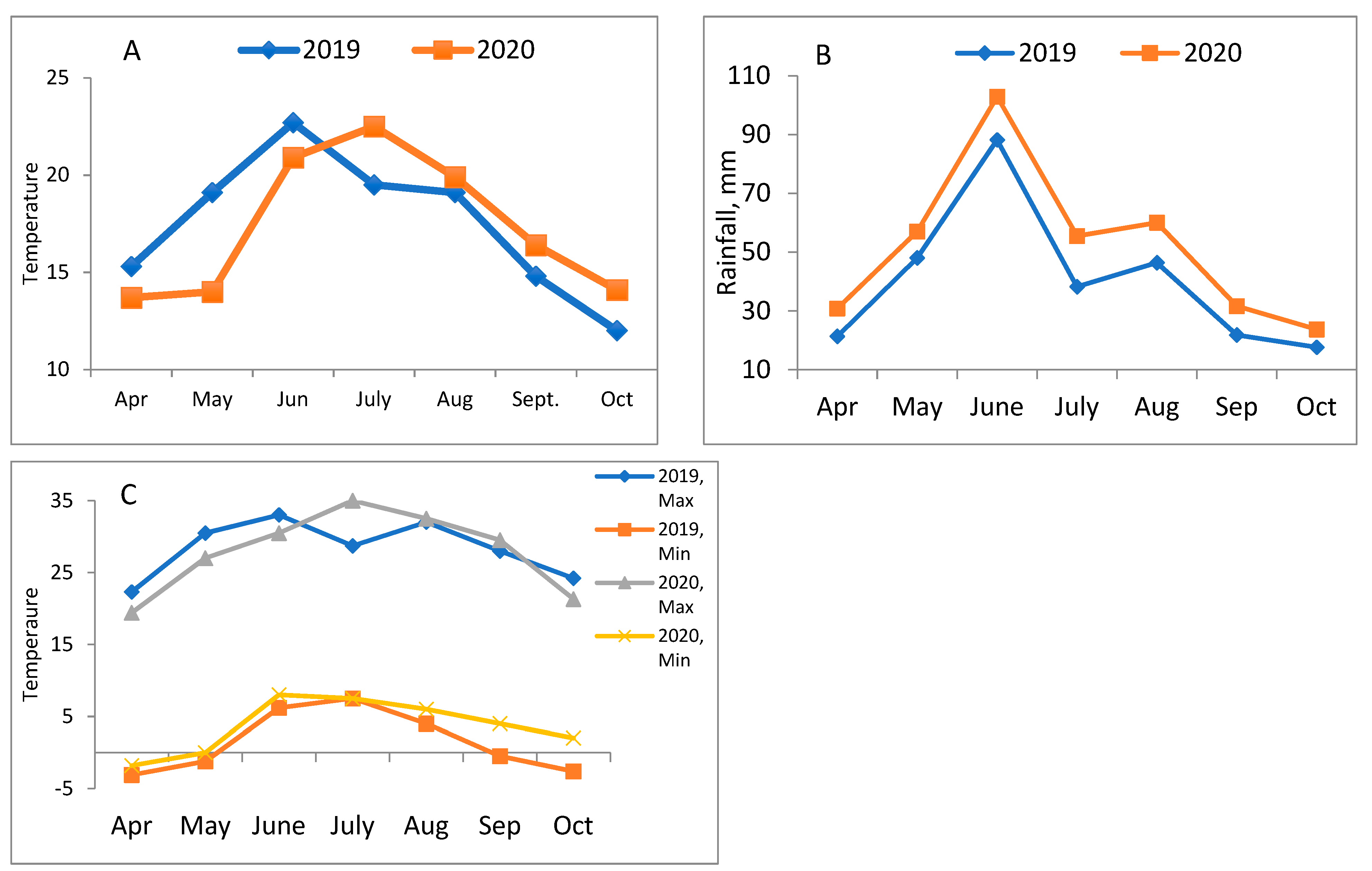
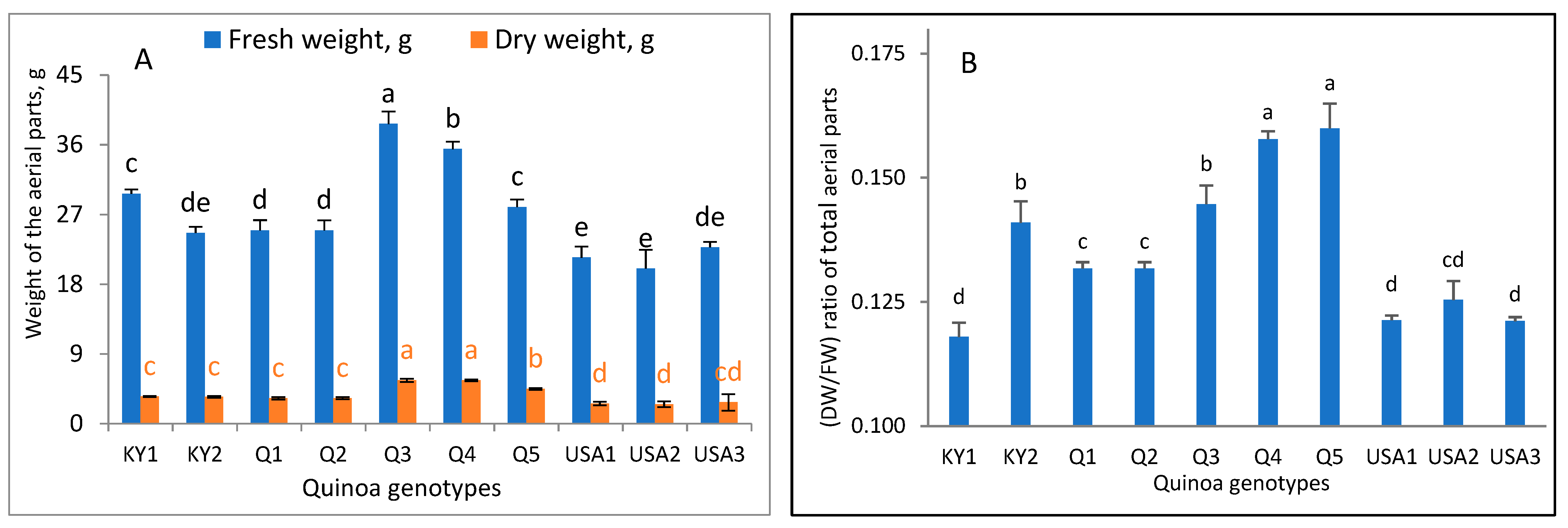
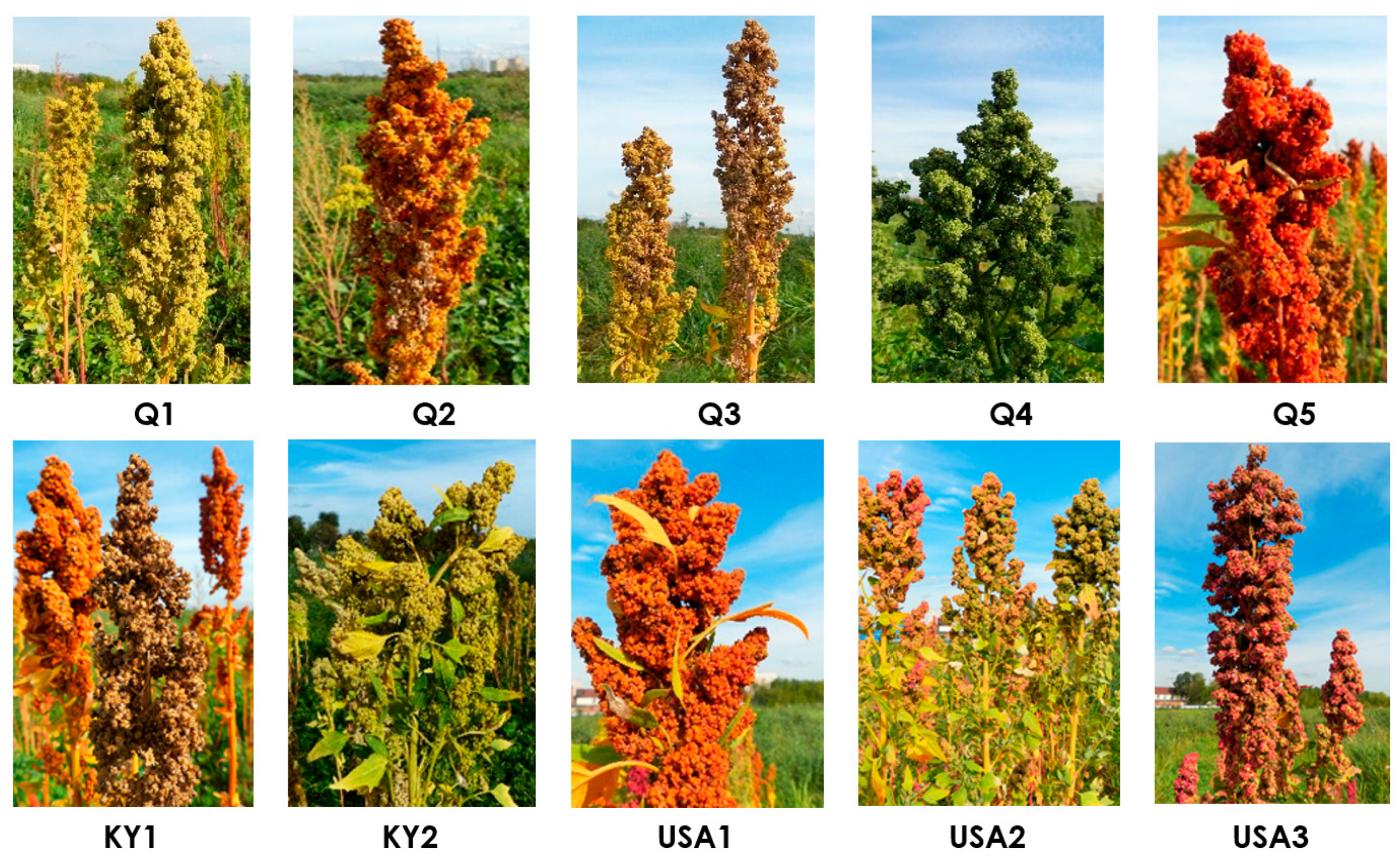
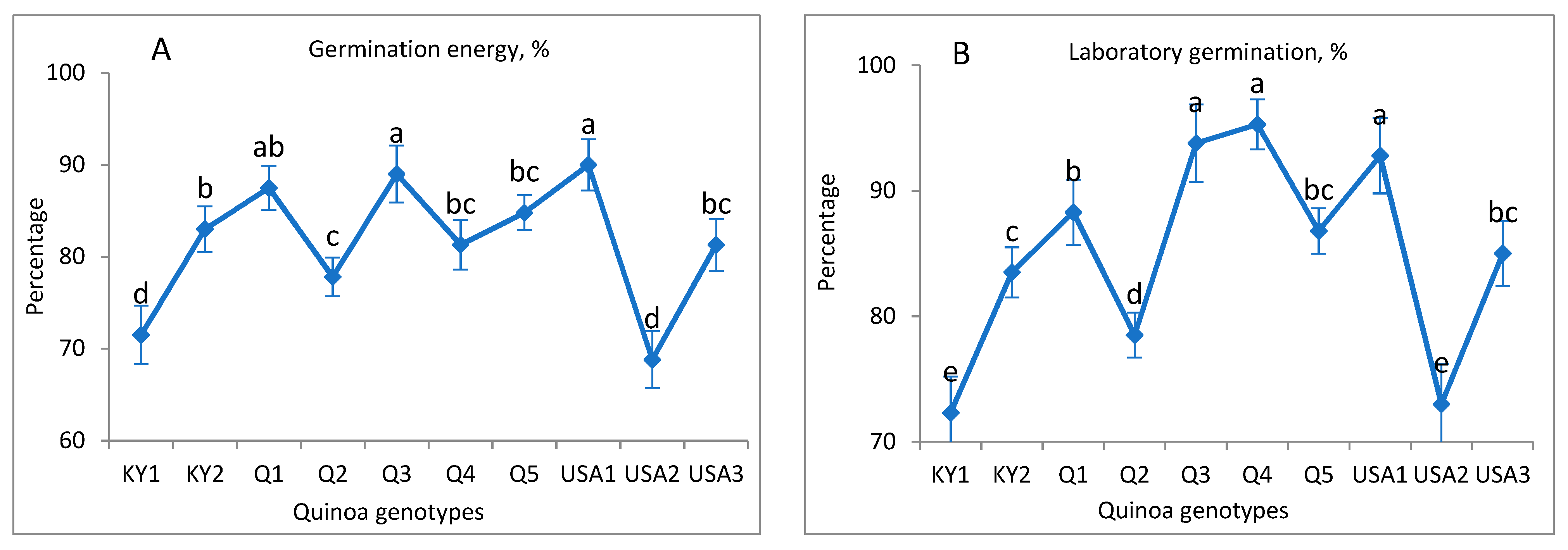
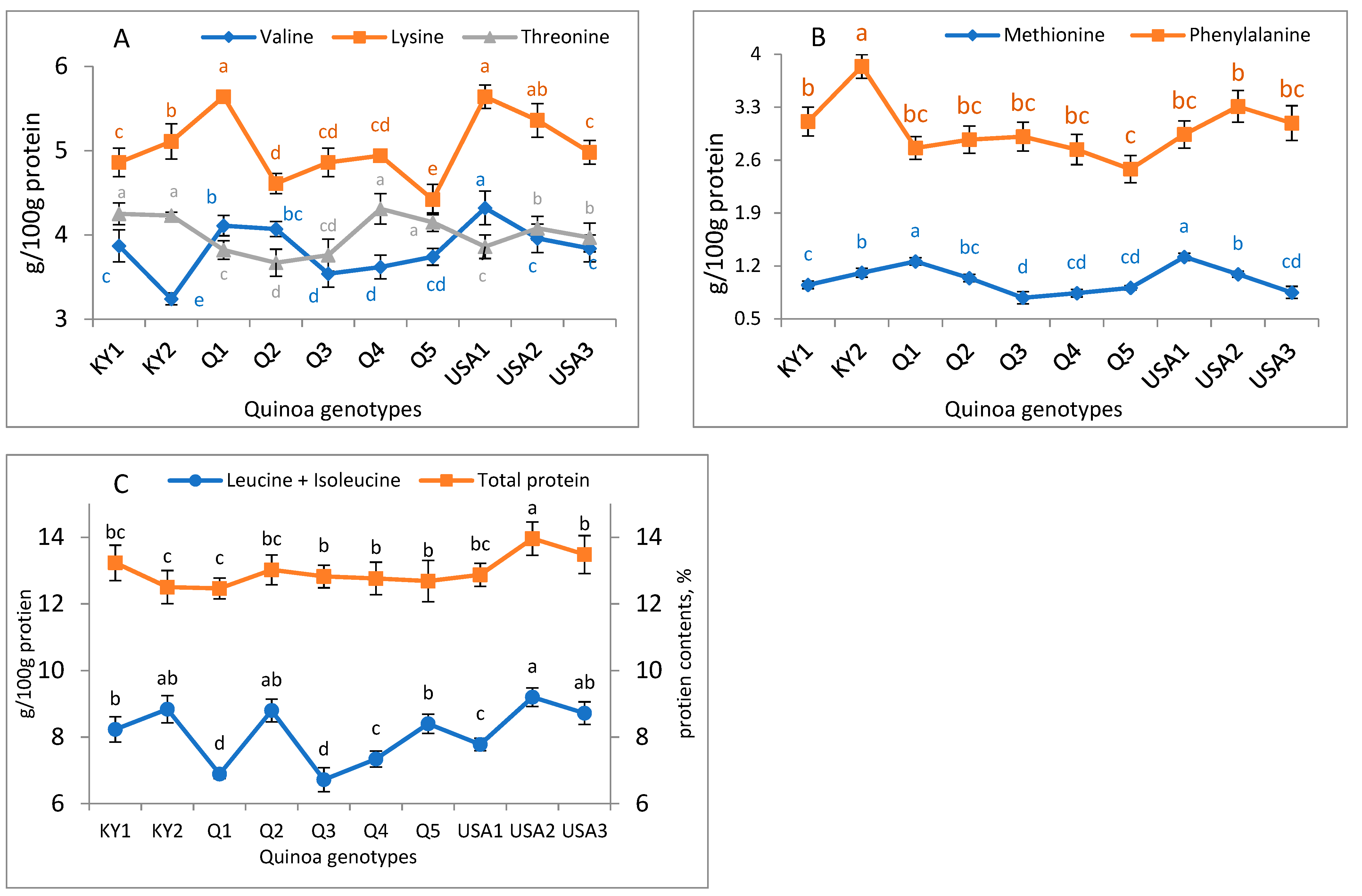
| Genotype | Panicle, g | Leaves, g | Stem, g | Total, g | ||||
|---|---|---|---|---|---|---|---|---|
| FW | DM | FW | DM | FW | DM | FW | DM | |
| KY1 | 0.892 bc ± 0.078 | 0.118 b ± 0.010 | 6.109 ab ± 0.536 | 0.843 b ± 0.073 | 1.364 b ± 0.124 | 0.328 b ± 0.030 | 8.371 b ± 0.601 | 1.289 ab ± 0.095 |
| KY2 | 0.683 c ± 0.058 | 0.086 bc ± 0.007 | 5.269 bc ± 0.331 | 0.713 c ± 0.045 | 0.954 bc ± 0.024 | 0.334 b ± 0.008 | 6.908 c ± 0.363 | 1.133 b ± 0.051 |
| Q1 | 1.024 b ± 0.100 | 0.153 b ± 0.015 | 4.728 c ± 0.383 | 0.718 c ± 0.058 | 0.973 b ± 0.090 | 0.118 d ± 0.011 | 6.719 c ± 0.339 | 0.989 bc ± 0.052 |
| Q2 | 0.809 bc ± 0.05 | 0.115 b ± 0.006 | 5.928 b ± 0.513 | 0.866 b ± 0.075 | 1.193 b ± 0.102 | 0.153 d ± 0.018 | 7.966 b ± 0.592 | 1.134 b ± 0.085 |
| Q3 | 1.422 a ± 0.124 | 0.234 a ± 0.020 | 5.820 b ± 0.476 | 0.931 b ± 0.076 | 1.835 a ± 0.132 | 0.236 c ± 0.017 | 9.017 a ± 0.392 | 1.401 a ± 0.058 |
| Q4 | 0.111 e ± 0.009 | 0.017 d ± 0.002 | 6.899 a ± 0.658 | 1.127 a ± 0.107 | 1.243 b ± 0.072 | 0.183 cd ± 0.011 | 8.253 b ± 0.726 | 1.327 a ± 0.118 |
| Q5 | 0.728 bc ± 0.021 | 0.12 b ± 0.004 | 5.338 b ± 0.341 | 0.900 b ± 0.058 | 1.172 b ± 0.069 | 0.480 a ± 0.028 | 7.237 c ± 0.287 | 1.497 a ± 0.044 |
| USA1 | 0.150 e ± 0.012 | 0.073 c ± 0.060 | 3.020 d ± 0.159 | 0.566 d ± 0.030 | 0.540 c ± 0.037 | 0.063 f ± 0.040 | 3.712 f ± 0.165 | 0.701 cd ± 0.031 |
| USA2 | 0.213 de ± 0.0203 | 0.028 c ± 0.003 | 3.860 d ± 0.237 | 0.533 d ± 0.033 | 0.719 c ± 0.060 | 0.083 e ± 0.007 | 4.791 e ± 0.280 | 0.644 d ± 0.038 |
| USA3 | 0.323 d ± 0.027 | 0.043 c ± 0.040 | 4.688 c ± 0.226 | 0.673 cd ± 0.032 | 0.881 bc ± 0.080 | 0.092 e ± 0.008 | 5.887 d ± 0.277 | 0.808 c ± 0.037 |
| Genotype | Leaves, g | Stem, g | Total, g | |||
|---|---|---|---|---|---|---|
| FW | DM | FW | DM | FW | DM | |
| KY1 | 6.05 bc ± 0.48 | 0.79 c ± 0.06 | 5.92 c ± 0.54 | 0.48 e ± 0.04 | 11.96 cd ± 0.91 | 1.27 d ± 0.10 |
| KY2 | 5.49 bc ± 0.54 | 0.70 d ± 0.07 | 5.42 c ± 0.34 | 0.57 d ± 0.04 | 10.92 d ± 0.85 | 1.27 d ± 0.10 |
| Q1 | 4.58 c ± 0.44 | 0.64 de ± 0.06 | 4.93 d ± 0.35 | 0.51 de ± 0.03 | 9.52 e ± 0.69 | 1.15 d ± 0.09 |
| Q2 | 6.74 b ± 0.65 | 0.47 f ± 0.05 | 7.01 b ± 0.60 | 0.72 c ± 0.06 | 13.75 b ±1.04 | 1.19 d ± 0.09 |
| Q3 | 6.41 b ± 0.42 | 0.91 b ± 0.06 | 9.79 a ± 0.56 | 1.12 a ± 0.06 | 16.20 a ± 0.85 | 2.02 b ± 0.11 |
| Q4 | 10.1 a ± 0.77 | 1.49 a ± 0.11 | 7.00 b ± 0.50 | 0.84 b ± 0.06 | 17.08 a ±1.16 | 2.32 a ± 0.16 |
| Q5 | 5.84 c ± 0.13 | 0.85 c ± 0.02 | 6.78 b ± 0.26 | 0.79 b ± 0.03 | 12.62 c ± 0.35 | 1.63 c ± 0.04 |
| USA1 | 6.13 b ± 0.42 | 0.76 cd ± 0.05 | 4.85 d ± 0.17 | 0.38 f ± 0.02 | 10.98 d ± 0.55 | 1.14 d ± 0.06 |
| USA2 | 4.58 c ± 0.43 | 0.56 e ± 0.05 | 3.24 f ± 0.40 | 0.30 f ± 0.03 | 7.83 f ± 0.37 | 0.86 e ± 0.05 |
| USA3 | 5.94 bc ± 0.59 | 0.81 c ± 0.08 | 4.18 e ± 0.37 | 0.35 f ± 0.03 | 10.13 de ± 0.86 | 1.16 d ± 0.10 |
| Genotype | Leaves, g | Stem, g | Total, g | |||
|---|---|---|---|---|---|---|
| FW | DM | FW | DM | FW | DM | |
| KY1 | 2.718 c ± 0.220 | 0.290 c ± 0.023 | 6.618 c ± 0.310 | 0.735 d ± 0.034 | 9.336 bc ± 0.400 | 1.025 e ± 0.044 |
| KY2 | 1.704 e ± 0.169 | 0.324 bc ± 0.032 | 5.085 e ± 0.467 | 0.740 d ± 0.068 | 6.788 d ± 0.592 | 1.064 e ± 0.092 |
| Q1 | 3.099 b ± 0.140 | 0.360 b ± 0.016 | 5.634 d ± 0.271 | 0.790 d ± 0.038 | 8.733 c ± 0.269 | 1.150 e ± 0.037 |
| Q2 | 2.996 b ± 0.259 | 0.350 b ± 0.030 | 7.096 c ± 0.629 | 1.111 b ± 0.099 | 10.089 b ± 0.791 | 1.461 d ± 0.117 |
| Q3 | 3.621 a ± 0.345 | 0.487 a ± 0.046 | 9.900 a ± 0.849 | 1.690 a ± 0.145 | 13.461 a ±1.038 | 2.173 a ± 0.154 |
| Q4 | 2.178 d ± 0.211 | 0.289 c ± 0.028 | 7.923 b ± 0.638 | 1.309 b ± 0.105 | 10.101 b ± 0.806 | 1.601 cd ± 0.128 |
| Q5 | 1.358 e ± 0.128 | 0.175 d ± 0.071 | 6.765 c ± 0.272 | 1.108 c ± 0.044 | 8.123 c ± 0.359 | 1.858 b ± 0.103 |
| USA1 | 2.018 d ± 0.190 | 0.165 d ± 0.016 | 4.748 e ± 0.197 | 0.593 e ± 0.025 | 6.766 d ± 0.258 | 0.758 f ± 0.028 |
| USA2 | 3.207 b ± 0.273 | 0.338 b ± 0.029 | 4.206 f ± 0.371 | 0.670 de ± 0.059 | 7.412 cd ± 0.513 | 1.008 e ± 0.072 |
| USA3 | 2.595 bc ± 0.119 | 0.311 c ± 0.014 | 4.153 f ± 0.414 | 0.478 f ± 0.048 | 6.747 d ± 0.491 | 0.799 f ± 0.057 |
| Genotypes | Panicle, cm | Number of Grains/Panicles | Grain Weight, g/Panicle | Weight of 1000 Grains, g | Grains Yield t/ha |
|---|---|---|---|---|---|
| KY1 | 34 d ± 1.1 | 6855 a ± 335 | 18.37 ab ± 1.00 | 2.68 c ± 0.04 | 4.08 a ± 0.22 |
| KY2 | 29 e ± 1.4 | 4610 c ± 287 | 13.00 d ± 0.88 | 2.82 bc ± 0.03 | 2.89 d ± 0.19 |
| Q1 | 39 c ± 2.1 | 4226 c ± 305 | 12.89 e ± 0.92 | 3.05 b ± 0.04 | 2.86 d ± 0.20 |
| Q2 | 43 c ± 1.4 | 4990 bc ± 414 | 14.97 c ± 1.20 | 3.00 b ± 0.04 | 3.33 b ± 0.27 |
| Q3 | 49 b ± 2.0 | 4322 c ± 373 | 13.96 cd ± 1.15 | 3.23 a ± 0.05 | 3.10 c ± 0.25 |
| Q4 | 56 a ± 1.7 | 4482 c ± 414 | 7.44 g ± 0.74 | 1.66 d ± 0.03 | 1.65 f ± 0.17 |
| Q5 | 32 de ± 0.8 | 6476 a ± 507 | 19.04 a ± 1.61 | 2.94 b ± 0.03 | 4.23 a ± 0.36 |
| USA1 | 32 de ± 1.8 | 3690 d ± 272 | 10.25 f ± 0.69 | 2.75 c ± 0.04 | 2.23 e ± 0.15 |
| USA2 | 30 e ± 1.1 | 4852 bc ± 250 | 13.04 d ± 0.58 | 2.86 bc ± 0.02 | 2.87 d ± 0.13 |
| USA3 | 37 cd ± 1.7 | 5891 b ± 481 | 17.79 b ± 1.56 | 3.21 a ± 0.03 | 3.89 a ± 0.25 |
Disclaimer/Publisher’s Note: The statements, opinions and data contained in all publications are solely those of the individual author(s) and contributor(s) and not of MDPI and/or the editor(s). MDPI and/or the editor(s) disclaim responsibility for any injury to people or property resulting from any ideas, methods, instructions or products referred to in the content. |
© 2023 by the authors. Licensee MDPI, Basel, Switzerland. This article is an open access article distributed under the terms and conditions of the Creative Commons Attribution (CC BY) license (https://creativecommons.org/licenses/by/4.0/).
Share and Cite
Voronov, S.; Pleskachiov, Y.; Shitikova, A.; Zargar, M.; Abdelkader, M. Diversity of the Biological and Proteinogenic Characteristics of Quinoa Genotypes as a Multi-Purpose Crop. Agronomy 2023, 13, 279. https://doi.org/10.3390/agronomy13020279
Voronov S, Pleskachiov Y, Shitikova A, Zargar M, Abdelkader M. Diversity of the Biological and Proteinogenic Characteristics of Quinoa Genotypes as a Multi-Purpose Crop. Agronomy. 2023; 13(2):279. https://doi.org/10.3390/agronomy13020279
Chicago/Turabian StyleVoronov, Sergey, Yurii Pleskachiov, Aleksandra Shitikova, Meisam Zargar, and Mostafa Abdelkader. 2023. "Diversity of the Biological and Proteinogenic Characteristics of Quinoa Genotypes as a Multi-Purpose Crop" Agronomy 13, no. 2: 279. https://doi.org/10.3390/agronomy13020279
APA StyleVoronov, S., Pleskachiov, Y., Shitikova, A., Zargar, M., & Abdelkader, M. (2023). Diversity of the Biological and Proteinogenic Characteristics of Quinoa Genotypes as a Multi-Purpose Crop. Agronomy, 13(2), 279. https://doi.org/10.3390/agronomy13020279







